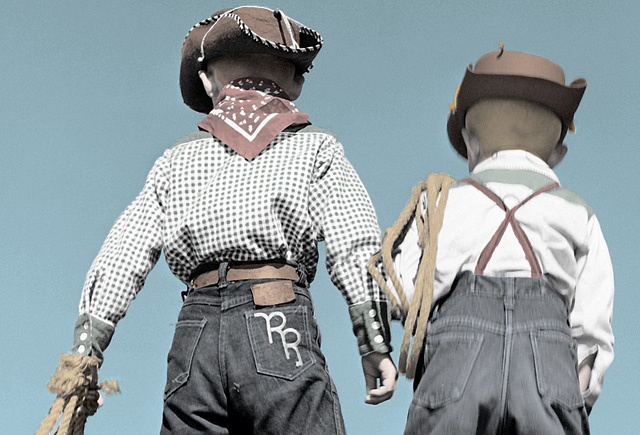The other day while doing yardwork, I noticed that my wife and helpmate was perspiring. I whipped out my trusty bandana for her to dry her face with and keep the stinging sweat out of her eyes. If you are outside in summer on the Texas Gulf Coast, you sweat, which is a good thing. It’s like nature’s sauna.
I slipped into one of those nostalgic moments and started thinking about my long relationship with the bandana: a large handkerchief bearing some type of patterned western motif, usually in shades of red or blue. The red-diamond ones remind me of John Wayne movies.
I can recall as a child always having a handkerchief in my back pocket, usually balled up and wet. I was never able to keep one white, and I used it on a runny nose. My mom didn’t like seeing the sleeve of my shirt or the cuff of my jacket stiff with dried—how can I be delicate here?—snot.
But the handy accessory had many other uses. It was great for wiping skinned knees and elbows. I could wet an end to clean dirt from my eyes. It served as a dandy headband that held a feather in its knot when I played Tonto; it was an eye patch when I became Blackbeard, the dreaded pirate.
Occasionally, it became a flag at my soldier fort or a banner on my fake bicycle antenna. I even used it as a slingshot to hurl the rock with which David killed Goliath.
In high school, I fancied myself a cattleman, and the bandana was a good wrap for injuries caused by barbed-wire fences. I even used it to wrap around the eyes of my show calf, Sugar, as I administered some treatment or other under the direction of our agriculture teacher.
During my Air Force days with all the survival schools and emergency medical training, I was amazed to find that emergency medical treatment was assisted with a basic issue of a cravat, another form of a bandana. It was used for everything from splinting a broken leg to making a sling for an injured arm, to serving as a constriction or tourniquet, to being part of a stretcher. Drably colored, it was the military version of the age-old and proven bandana.
When I retired from the Air Force and the National Guard and began teaching, I noticed that the students in my classes were not acquainted with the form or function of a handkerchief, much less a bandana. Boys, I mean, come on. A handkerchief or bandana is a sign of masculinity.
John Wayne, Hopalong Cassidy, the Cisco Kid and even Roy Rogers wore bandanas. With all these good role models, where had our society gone wrong?
Well, I guess all this is lost now. Nowadays, you can just reach for a lanolin-laced tissue, use it, throw it away and enjoy a non-chapped nose. I checked the oil in my pickup with a tissue once, but I made sure no one was looking. A tissue has its purposes, but you have to admit that they are extremely limited.
(Sergeant on the battlefield: “Quick, hand me a tissue! I’ve got to tend to this man’s wound!”)
Like the bandana, I feel obsolete. But the bandana really can’t be replaced with anything but another bandana. Even after it wears out, it can be cut up and used as a rag.
I read about a most interesting use of the bandana: A young lady was trying to train her newly purchased horse that had the bad manners to bite her on the backside whenever she was about to throw the saddle on its back. So she boiled a potato, wrapped it in a bandana while it was still hot and stuck it in her back pocket. This time when she started to throw on the saddle, the horse bit into the potato and was instantly cured of its bad habit.
——————–
Kenneth L. Canion and his wife have a permanent residence in West Columbia, Texas, and spend part of each summer in Port O’Connor.


